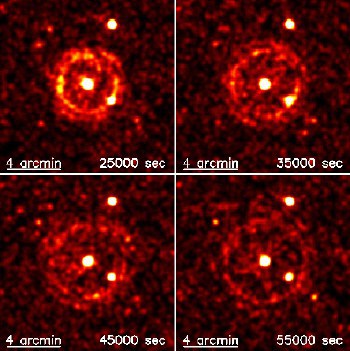Astronomers have obtained the first images of X-ray “halos” around the location of a gamma-ray burst. Simon Vaughan of Leicester University in the UK and co-workers used the XMM-Newton observatory to study GRB 031203, a gamma-ray burst that happened in December. The results could shed new light on the origins of gamma-ray bursts - the most powerful explosions in the universe (Astrophysical Journal to be published; arxiv.org/abs/astro-ph/0312603).

Although gamma-ray bursts were discovered in the 1960s, they are still not fully understood. Some astronomers believe that they happen when a massive star undergoes a supernova explosion at the end of its life and collapses to form a black hole.
On 3 December 2003, a gamma-ray burst lasting about 30 seconds was detected by the Integral satellite in a small galaxy about a billion light years away. A few hours later, Vaughan and colleagues in the US, Denmark and Spain began studying the fading “afterglow” of the burst at X-ray wavelengths with the EPIC cameras on XMM-Newton. They observed a fuzzy halo of X-ray light around the expected position of GRB 031203.
“At first, we thought something had gone wrong with the observation,” Vaughan told PhysicsWeb. “However, we then looked at how this fuzziness changed with time and saw that it was a set of expanding rings.” According to the team, the rings are seen because X-rays from the gamma-ray burst illuminate and scatter dust in our galaxy. X-rays from more distant dust reach Earth later, so it appears that the rings are expanding. Indeed, the halo appears to be expanding at 1000 times the speed of light, but that is merely an optical illusion.
The researchers deduced that there must be two sheets of dust between the gamma-ray source and Earth because they observed two rings (see figure). By measuring the size of the rings, they calculated that the first dustsheet lies about 2900 light years away from Earth and the second at about 4500 light years.
“Dust helps cool gas clouds, which can then collapse to form stars and planets,” said Vaughan. “So knowing where dust is located helps us determine where star and planets are likely to form.” Moreover, the delayed X-rays provide information on the original brightness of GRB 031203. These measurements could help astronomers better understand gamma-ray bursts and learn more on how black holes and galaxies form.



